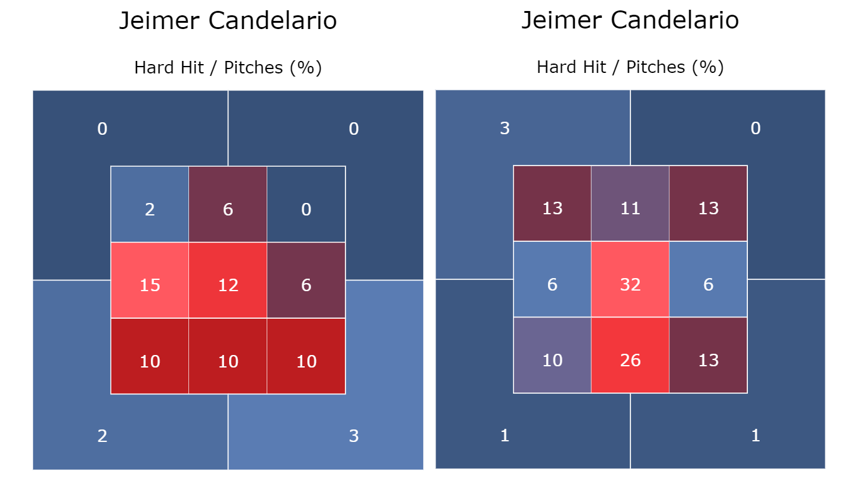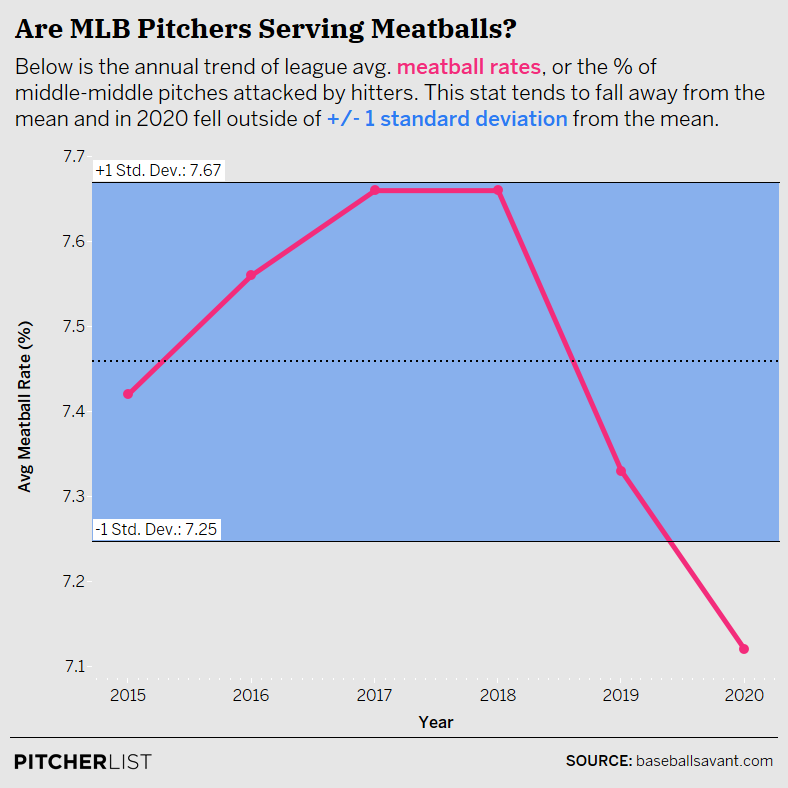It was a confusing, difficult year for everyone in 2020 (and in 2021 so far), and it was a weird year for baseball too.
The 60-game season we had last year is destined to wreak havoc on fantasy baseball analysts as we try to decide how much you can trust the performances of certain players, given that 50-60 games is hardly a sample size you can typically draw meaningful conclusions from (that’s like determining the MVP vote in early June).
So, naturally, we’re going to get a handful of players who either had a big breakout or a big slump last year and we’re going to wonder how much we should either be encouraged or concerned.
Yes, we do that every year, but typically there’s more data to work with to draw conclusions that don’t feel like they’re built on sand. Unfortunately, we’re going to be building sandcastles a lot more this baseball preseason than not.
I want to take a look at one of those breakouts from 2020 that has had me extremely intrigued for a while now.
The Breakout of Jeimer Candelario
Last year, in 52 games, Jeimer Candelario had himself a time, slashing .297/.369/.503, and if you pace out his counting stats to a full season, we’re looking at a guy who hits 20+ home runs and goes roughly 80/80 in runs and RBI.
That’s no superstar, but that kind of play is an extremely useful player in fantasy (think Hunter Dozier in 2019 or Nick Castellanos in 2018), and it’s light years away from what Candelario had been doing up to that point.
In 2019, Candelario slashed .204/.306/.337 in 94 games, and in 2018, he slashed .224/.317/.393 in 144 games—his first full season in the majors—so to see him do what he did last year, that’s a big change.
Now, you and I both know that baseball players, especially young ones like Candelario (who just recently turned 27), can break out at almost any time. All they need is a tweak to their approach, their swing, a visit to Driveline, getting into the #bestshapeoftheirlife (actually not that one), or any other number of things.
So now, with just a 52-game sample size, I want to know—can we trust Jeimer Candelario’s breakout? Let’s take a look.
What Did Jeimer Candelario Do Differently Last Year?
I think the only way to really determine whether a player’s breakout in a shortened season like 2020 is trustworthy or not is to look for a definitive skill change. Something in the way that a player approaches the game specifically changed. So what did Candelario do differently?
The answer to that question is kind of odd—because, in a lot of ways, Jeimer Candelario in 2020 looked a lot like Jeimer Candelario in the past. But in a few important ways, 2020 looked different.
Take a look at some of his quality of contact stats between 2019 and 2020:
| Avg. Exit Velocity | Avg. Launch Angle | Barrel % | Hard Hit % | |
|---|---|---|---|---|
| 2018 | 87.2 | 15 | 6% | 33.6% |
| 2019 | 88.2 | 15.8 | 5.9% | 33.8% |
| 2020 | 90.2 | 13.3 | 10.3% | 47.1% |
Candelario saw a huge jump in barrel rate and hard-hit rate, and a career-best average exit velocity. In fact, that jump in hard-hit rate represented the fifth-biggest year-to-year increase in the hard-hit rate in baseball last year.
I look at that and say, “Ah okay, so he made a change in his approach, so we should see some other changes in the type of contact he was making, especially given his launch angle dropped.”
But that doesn’t exactly seem to be the case.
| LD% | GB% | FB% | IFFB% | HR/FB | Pull% | Cent% | Oppo% | |
|---|---|---|---|---|---|---|---|---|
| 2018 | 17.7% | 41.7% | 40.6% | 12.2% | 12.2% | 46.6% | 30.2% | 23.2% |
| 2019 | 22.9% | 39.8% | 39.8% | 9.6% | 8.5% | 47.7% | 32.9% | 19.4% |
| 2020 | 25.9% | 40% | 34.1% | 8.7% | 15.2% | 41.9% | 39.7% | 18.4% |
There are differences in Candelario’s type of contact, for sure. Line drives increased a bit, for example, which is great, but Candelario also saw a drop in fly balls accompanied by a significant rise in HR/FB rate.
That’s usually a big red flag because it means he was hitting fewer fly balls, but a bigger portion of those fly balls were home runs, which suggests he may have been getting a bit lucky.
He also didn’t see a rise in pull rate, something you would typically (though not always) expect from a player who’s discovered their power. Instead, Candelario has started hitting more balls to center field, which is not the best place to hit the ball if you’re looking to hit home runs.
How Did He Do It?
Clearly, he did something, right? You typically don’t just randomly pump up your barrel rate/hard-hit rate/average exit velocity on accident. Naturally, my first thought was, did Candelario make some change in his approach?
Here’s a look at Candelario’s swing in 2020 (left) compared to 2019 (right):
https://gfycat.com/sorenauticalilladopsis
The difference isn’t huge, in fact, it’s hardly there at all. The only thing I’m seeing is a bit more of a controlled step on the left compared to the right, a bit smoother.
That would make sense given what Detroit Tigers beat writers reported on Candelario last year. Evan Petzold reported in the Detroit Free Press in September last year that Candelario had made mechanical changes specifically focused on his legs.
Joe Vavra, the Tigers’ hitting coach last year, even gave a sort of a vague description of what he’s seen in Candelario’s approach:
“That base of his swing is the most important part of it,” Vavra said. “He’s got a real good foundation. It keeps him where he can stay inside the ball batter and really handle the whole plate, especially the outside corner. That’s where guys fail.”
Candelario himself also said he really focused on his mechanics coming into 2020.
“When you hit line drives, homers will come,” Candelario said. “Putting in a lot of effort to put the barrel on the ball. Controlling my body is helping me a lot.”
All of this together says to me Candelario made some very specific, small changes in his approach this past year and they stuck, which could help explain the increases in quality of contact.
There was also a pretty clear focus on his plate discipline and being more aggressive at the plate. Take a look at his plate discipline stats over the years:
| O-Swing % | Z-Swing % | Swing % | Zone % | SwStr % | Meatball Swing % | |
|---|---|---|---|---|---|---|
| 2018 | 28.6% | 61.9% | 42.7% | 42.4% | 10.1% | 66.7% |
| 2019 | 31% | 62.4% | 43.7% | 40.3% | 10.7% | 61.1% |
| 2020 | 29.9% | 69.3% | 44.8% | 37.8% | 11.4% | 87.2% |
Now, if you’re like me, probably one of the first things you noticed is that giant jump in meatball swing rate and then immediately said “wait, what’s a meatball?”
Meatballs are defined by Statcast fairly simply—according to Daren Willman, they’re “middle middle pitches,” essentially mistake pitches right down the heart of the plate.
When I first saw that giant jump I thought the same thing Thorn thought in Soylent Green—the secret is in the meatballs.
Here’s how the theory went in my head—if Jeimer Candelario was hitting a whole bunch more meatballs, then that would definitely explain a portion of his sudden increase in exit velocity and barrel rate because if you’re likely to destroy any pitch, it’s going to be a meatball. And since the meatball rate isn’t very sticky year-to-year (more on that in a second), it’s reasonable to be skeptical of Candelario’s advancements.
But, the data didn’t bear that out, because while his meatball swing rate jumped significantly, his actual meatball rate (as in the percentage of meatballs he hit) sat at 5.6%, a career-low.
Instead, in my view that big jump in meatball swing rate in part speaks to the bigger story of Candelario’s change at the plate—he’s more aggressive now.
His chase rate dropped a bit, which is good (though it’s relatively the same as 2018, so not a major difference), but notice that his swing rate at pitches in the strike zone jumped way up, as did his contact rate with pitches in the zone, and his overall swing rate.
He’s picking up on pitches he should swing at more, and when you can pick up on pitches in the zone more frequently, you’re probably going to make more quality contact.
To an extent though, I do think my meatball theory has some truth to it. Take a look at where Candelario’s hard-hit balls were in 2019 (left) compared to last year (right):

That concerns me a little. Why? Because a large portion of Candelario’s hard-hit balls last year was down the middle of the plate (those meatballs).
On the one hand, I’m glad to see Candelario is getting better at recognizing when he’s got a good pitch to hit, clearly he did that last year and it helped, but you also can’t count on getting any certain number of mistake pitches each year.
Earlier I said meatball rates aren’t sticky year-to-year, and that’s exactly what you’ll find if you look into it. In fact, meatball rates took relatively big dives in 2019 and 2020:

Data Visualization by @Kollauf on Twitter
You can’t count on mistake pitches being consistent. If I’m thinking a guy’s hard-hit rate surge is going to stick going into the following year, I want to see him hitting the ball better all over the zone, not just down the heart of the plate.
So Can I Trust Him or Not?
We’ve gone through a whole lot of data here, so let’s sum everything up. What does it appear Candelario did last year that’s different from years past?
- He made small tweaks to his mechanics
- He’s hitting the ball harder with better-quality contact
- He’s more aggressive at the plate
I think there’s a good bit to like about the changes Candelario made last year. I like that he has a focused approach to the plate, I like that he’s dedicated to working on the holes in his approach, that he knows what he needs to do, and is making mechanical changes to do it. That’s really encouraging and speaks to his attitude towards the game.
I also like that he’s more aggressive at the plate, I like that he’s recognizing when a good pitch to hit comes by and he’s taking advantage of it.
However, I worry about how that’s going to carry over next year. I worry that a decent portion of Candelario’s advancements in the quality of contact were thanks to him taking advantage of mistake pitches more than it was him making better-quality contact across the board.
Here’s the nice thing about Candelario though—he will almost definitely be very cheap in drafts. As of this writing, his NFBC ADP (which, admittedly, it’s early) is 237. That’s essentially free.
So if you’re asking me whether you can trust that the Jeimer Candelario we saw in 52 games last year is the new Jeimer Candelario of the future, I can’t say that I feel safe making that conclusion. It’s definitely possible, the tools are there, but there’s reason to be skeptical.
However, if you’re asking me whether he’s worth taking a flier on late in drafts just in case those changes stick, my answer to that is an enthusiastic yes.
There’s virtually no risk grabbing him that late in drafts, and if the payoff is a guy who’s going to hit 20ish home runs with roughly 80/80 runs/RBI production hitting in the .280s/.290s, that’s a fantastic value.
Photos by Jeff Chevrier and Lawrence Iles /Icon Sportswire | Adapted by Jacob Roy (@jmrgraphics3 on IG)


Candelario has some split issues where he received a huge boost to his profile. It is worth checking it out because in the small sample his numbers got pushed up.
For sure, he’s always been a lefty masher, though he even made some strides in hitting against righties last year too.
Certainly it’s a small sample size, but it’s clear he’s aware of his problems and making some specific changes, so hopefully they stick! Either way, I think he’s definitely worth a flier in drafts
There is something wrong with batted balls percentages presented. They don’t add up to 100%. According to fangraphs his GB% increased to 40%…
Good catch! That was a typo – it’s been fixed